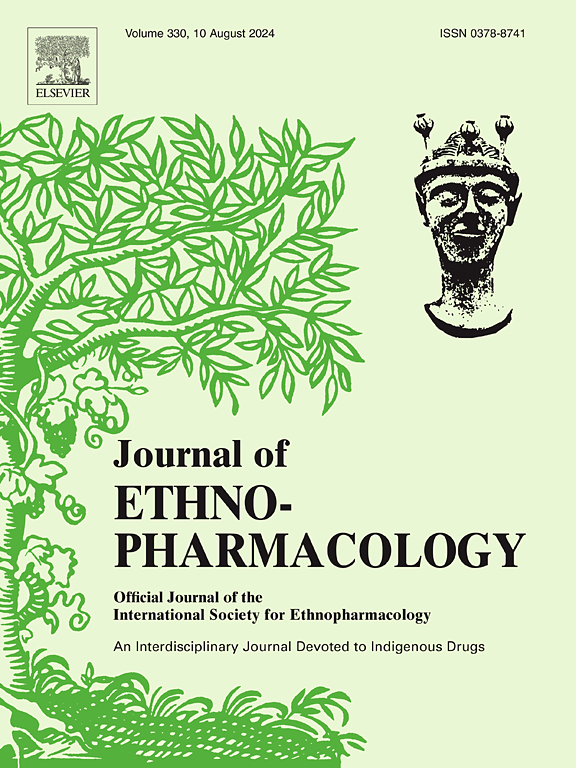Niuhuang jiedu prescription alleviates realgar-induced dopaminergic and GABAergic neurotoxicity in Caenorhabditis elegans
IF 4.8
2区 医学
Q1 CHEMISTRY, MEDICINAL
引用次数: 0
Abstract
Ethnopharmacological relevance
Niuhuang Jiedu (NHJD) is a Chinese medicine prescription containing realgar (As2S2), which is neurotoxic, and seven other traditional Chinese medicines (TCMs). However, whether the multiple TCMs contained in NHJD can mitigate the neurotoxicity of realgar is yet to be elucidated.
Aim of the study
This study aimed to investigate the effect of NHJD on realgar-induced neurotoxicity and elucidate its underlying mechanisms.
Material and methods
Caenorhabditis elegans was treated with realgar suspension (1–8 mg/mL) for 48 h. Transgenic nematode strains labeled with green fluorescent protein were used to evaluate neuronal structural damage. Locomotion and perception behaviors were assessed by measuring head thrashes, body bends, and chemotaxis. Oxidative stress was determined by detecting reactive oxygen species (ROS), lipofuscin, and glutathione-S-transferase-4 (GST-4) levels. Subsequently, a quantitative reverse transcription–polymerase chain reaction was employed to analyze gene expression associated with oxidative stress, whereas the role of the p38 MAPK pathway was investigated using KU25 nematodes. Finally, arsenic species in the nematodes were estimated using high-performance liquid chromatography–atomic fluorescence spectrometry. Data analysis was performed using analysis of variance or rank tests with SPSS 26.0.
Results
Treatment of nematodes with 8 mg/mL realgar resulted in significant damage to dopaminergic and GABAergic neurons, impaired locomotor and perceptual behavior (at 4–8 mg/mL), and induced oxidative damage (at 2–8 mg/mL). A neuron-defective model was established using 8 mg/mL realgar to gauge the effects of NHJD on realgar-induced damage. The findings indicated that NHJD, containing the same dose of realgar, significantly alleviated neuronal damage and neurobehavioral impairment and increased ROS, lipofuscin, and GST-4 levels. In addition, NHJD reduced the expressions of oxidative stress-related genes (gst-4, skn-1, gcs-1, gss-1, ctl-2, ctl-3, and sod-1) compared with realgar alone. Nonetheless, significant differences in skn-1 expression, neurobehavior, ROS, or lipofuscin levels were not observed between the realgar and NHJD groups in KU25 nematodes. Moreover, arsenic methylation metabolites were not identified in the nematodes.
Conclusions
The multiple TCMs contained in NHJD effectively mitigated realgar-induced dopaminergic and GABAergic neurotoxicity in nematodes, and pmk-1 may play a crucial role in NHJD's alleviating realgar-induced neurotoxicity via the p38 MAPK signaling pathway.

牛黄解毒方减轻雄黄诱导的秀丽隐杆线虫多巴胺能和gaba能神经毒性。
民族药理学相关性:牛黄解毒(NHJD)是一种含有具有神经毒性的雄黄(As2S2)和其他七种中药的中药方剂。然而,nhtd中所含的多种中药是否能减轻雄黄的神经毒性尚不清楚。研究目的:探讨NHJD对雄黄诱导的神经毒性的影响,并阐明其作用机制。材料与方法:用雄黄悬浮液(1 ~ 8 mg/mL)处理秀丽隐杆线虫48 h,用绿色荧光蛋白标记转基因线虫株评价其神经元结构损伤。通过测量头部抽搐、身体弯曲和趋化性来评估运动和感知行为。通过检测活性氧(ROS)、脂褐素(lipofuscin)和谷胱甘肽- s -转移酶4 (GST-4)水平来检测氧化应激。随后,采用定量逆转录-聚合酶链反应来分析与氧化应激相关的基因表达,而使用KU25线虫研究p38 MAPK途径的作用。最后,采用高效液相色谱-原子荧光光谱法对线虫中砷的种类进行了估计。数据分析采用SPSS 26.0进行方差分析或秩次检验。结果:8 mg/mL雄黄对线虫多巴胺能神经元和gaba能神经元造成明显损伤,运动和感知行为受损(4 ~ 8 mg/mL),并诱导氧化损伤(2 ~ 8 mg/mL)。采用8 mg/mL雄黄建立神经元缺损模型,观察NHJD对雄黄损伤的影响。结果表明,含有相同剂量雄黄的NHJD可显著减轻神经损伤和神经行为障碍,并增加ROS、脂褐素和GST-4水平。此外,与雄黄相比,NHJD降低了氧化应激相关基因(gst-4、skn-1、gcs-1、gss-1、ctl-2、ctl-3和sod-1)的表达。然而,在KU25线虫中,雄黄组和NHJD组在skin -1表达、神经行为、ROS或脂褐素水平上没有观察到显著差异。此外,在线虫中未发现砷甲基化代谢物。结论:NHJD中含有的多种中药可有效减轻雄黄诱导的多巴胺能和gaba能神经毒性,pmk-1可能通过p38 MAPK信号通路在NHJD减轻雄黄诱导的神经毒性中发挥重要作用。
本文章由计算机程序翻译,如有差异,请以英文原文为准。
求助全文
约1分钟内获得全文
求助全文
来源期刊

Journal of ethnopharmacology
医学-全科医学与补充医学
CiteScore
10.30
自引率
5.60%
发文量
967
审稿时长
77 days
期刊介绍:
The Journal of Ethnopharmacology is dedicated to the exchange of information and understandings about people''s use of plants, fungi, animals, microorganisms and minerals and their biological and pharmacological effects based on the principles established through international conventions. Early people confronted with illness and disease, discovered a wealth of useful therapeutic agents in the plant and animal kingdoms. The empirical knowledge of these medicinal substances and their toxic potential was passed on by oral tradition and sometimes recorded in herbals and other texts on materia medica. Many valuable drugs of today (e.g., atropine, ephedrine, tubocurarine, digoxin, reserpine) came into use through the study of indigenous remedies. Chemists continue to use plant-derived drugs (e.g., morphine, taxol, physostigmine, quinidine, emetine) as prototypes in their attempts to develop more effective and less toxic medicinals.
 求助内容:
求助内容: 应助结果提醒方式:
应助结果提醒方式:


